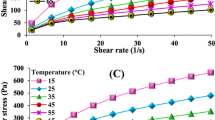Abstract
The rheological behaviour of eight tomato ketchups measured in the shear rate range from 0.1 to 100 1/s and with oscillatory tests was studied over a wide range of temperatures (0–50 °C) using a Physica UDS 200 rheometer. The results indicated that these tomato ketchups behave as non-Newtonian fluids semi-solid and have a definite yield stress. The relationship between ηeff and temperature of all the tomato ketchup brands under investigation was examined. Significantly higher correlation was found between ηeff and temperature. The ηeff values decrease with an increase in temperature. Oscillatory test data revealed weak gel-like (dispersion structure) behaviour of the ketchup: the magnitudes of G′ were higher than those of G″, and both increased with oscillatory frequency. The effect of temperature on the viscosity can be described by means of an Arrhenius-type equation. The flow activation energy for viscous flow depends on the chemical composition; the flow activation energy increases with the total solids contents. Chemical, physical and sensory tests for tomato ketchups were made.


Similar content being viewed by others
References
Gupta RK (1998) SBP handbook of export oriented food processing projects. SBPPF Book Store, SBP Consultants and Engineers
Porretta S, Birzi A (1995) Sci-Aliments 15:529–540
Porretta S (1991) J Sci-Food Agric 57:293–301
Rao MA (1987) Food Technol 41:85–88
Thomas HA, Sidel JL, Stone H (1995) Relationships between rheological and sensory properties of liquid foods. Trogon Corporation Symposium, USA
Szczeniak A (1987) J Texture Stud 18:1–15
Houska M, Valentova H, Novotna P, Strohalm J, Sestak J, Pokorny J (1998) J Texture Stud 14:603–615
Porretta S, Sandei L, Leoni C (1989) Ind Conserve 64:21–27
Rani U, Banins GS (1987) J Texture Stud 18:125–135
Bottiglieri P, DeSio F, Fasanaro G, Mojoli G, Impembo M, Castaldo D (1991) J Food Qual 14:497–512
Bistany KL, Kokini JL (1983) J Texture Stud 14:113–124
Bistany KL, Kokini JL (1983) J Rheol 27:605–620
Association of Official Analytical Chemists (1995) Official methods of analysis, 16th edn. Association of Official Analytical Chemists, USA
Pearson D (1976) The chemical analysis of food, 7th edn. Churchill, London
El-Mansy HA, Bahlol HElM, Mahmoud MH, Sharoba AMA (2000) AnnAgric Sci Moshtohor 38:1521–1538
Meydov S, Saguy I, Kopelman IJ (1977) J Agric Food Chem 25:602
Wettestein DV (1957) Exp Cell Res 12:427–433
Ranganna S (1997) Manual of analysis of fruit and vegetable products. Tata McGraaw-Hill, New Delhi, India.
Alvarado JD (1991) J Food Process Eng 14:189–195
Senge B (2001) Optimierung des Transport- und Mischverhaltens nicht-Newtonischer plastischer Medien am Beispiel von Speisequark. GDL-Kongress, Lebensmitteltechnologie, 8–10 November 2001, Berlin, Germany
Rao MA, Cooley HJ (1992) J Texture Stud 23:415–425
Yoo B, Rao MA (1996) J Texture Stud 27:451–459
El-Mansy HA, Bahlol HElM, Mahmoud HM, Sharoba AMA (2000) Ann Agric Sci Moshtohor 38:1557–1574
Ibarz A, Garvin A, Casta J (1996) J Food Eng 27:423–430
Gomez KA, Gomez AA (1984) Statistical procedures for agriculture research, 2 edn. Wiley, New York, pp 129–184
Canovas GV, Peleg M (1983) J Texture Stud 14:213–234
France Centre de Recherches Foch (1990) Tomato ketchup. Med Nutr 26:319
Orzaez MT, Matallana MC, Palomino P, Valdehita MT, Diaz A (1991) Anal Bromatol 4345–49
Vitacel (2002) Tomato ketchup made with Vitacel tomato fiberhttp://www.jrs.de/jrs/uk/nm/a_tomato.htm
Sharoba AMA (1999) Rheological studies on some foods. MSc thesis. Zagazig University, Egypt.
Tonucci LH, Holden JM, Beecher GR, Khachik F, Davis CS, Mulokozi G (1995) J Agric Food Chem 43:579–586
Djuric Z, Powell LC (2001) Int J Food Sci Nutr 52:143–149
Tavares CA, Rodriguez DB (1994) Lebensm-Wiss Technol 27:219–222.
Wilberg VC, Rodriguez DB (1993) Cien Tecnol Aliment 13:132–141
Saravacos GD, Kostaropoulos AE (1995) Food Technol 9:99–105
Ramos AM, Ibarz A (1998) J Food Eng 35:57–63
Lewis MJ (1987) Physical properties of foods and food processing systems. Ellis Harwood, Chichester, UK, pp 220–229
Chaffai AH (1991) Sci Aliments 11:673–681
Young IL, Seung JL, Wan SN (1997) Agric Chem Biotechnol 40:48–52
Toledo RT (1980) Fundamentals of food process engineering. AVI, West Port, CT, pp 152–196
Charm SE (1980) Fundamentals of food engineering. AVI, West Port, CT, pp 54–78
Bayindirli (1992) J Food Process Preserv 16:23–28
Vanwazer JR, Lyons JW, Kin KY, Colwell RE (1963) Viscosity and flow measurement. Interscience, New York
Singh NI, Eipeson WE (2000) J Texture Stud 31:287–295
Yoo B (2001) J Texture Stud 32:307–318
Harper JC, El Sahrigi AF (1965) J Food Sci 30:470–476
Rao MA, Bovrne MC, Cooley HJ (1981) J Texture Stud 12:521–538
Kunzek H, Opel H, Senge B (1997) Z Lebensm Unters Forsch 205:193–203
Mezger T (2003) Characterization of the structure at rest in foods (example: ketchup). Food/campden-11-03/ ketchup-struc-at-rest 1 August 2003. Mez. Physica Messtechnik, Ostfildern, Germany
Steffe JF (1996) Rheological methods in food process engineering, 2nd edn. Freeman, East Lansing, MI
Jimenez L, Ferrer L, Paniego ML (1989) J Food Eng 9:119–128
Author information
Authors and Affiliations
Corresponding author
Rights and permissions
About this article
Cite this article
Sharoba, A.M., Senge, B., El-Mansy, H.A. et al. Chemical, sensory and rheological properties of some commercial German and Egyptian tomato ketchups. Eur Food Res Technol 220, 142–151 (2005). https://doi.org/10.1007/s00217-004-0981-7
Received:
Revised:
Published:
Issue Date:
DOI: https://doi.org/10.1007/s00217-004-0981-7



